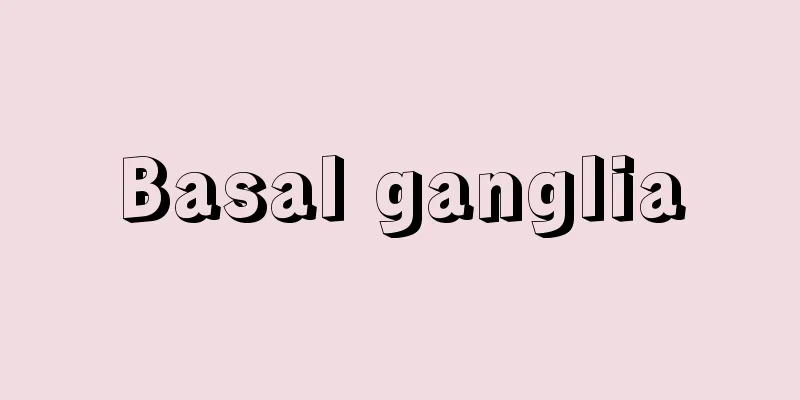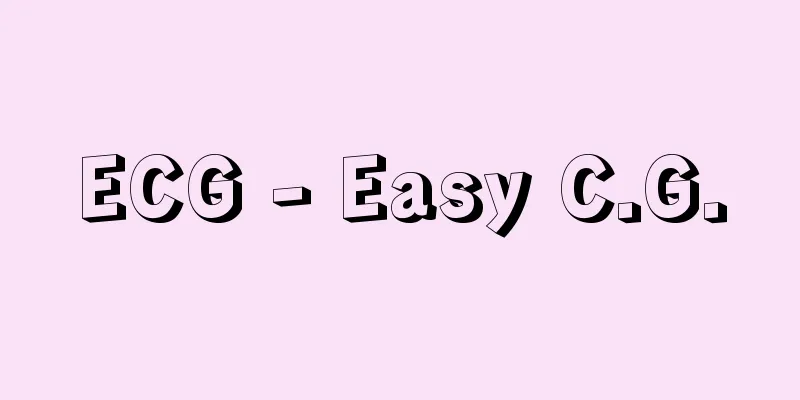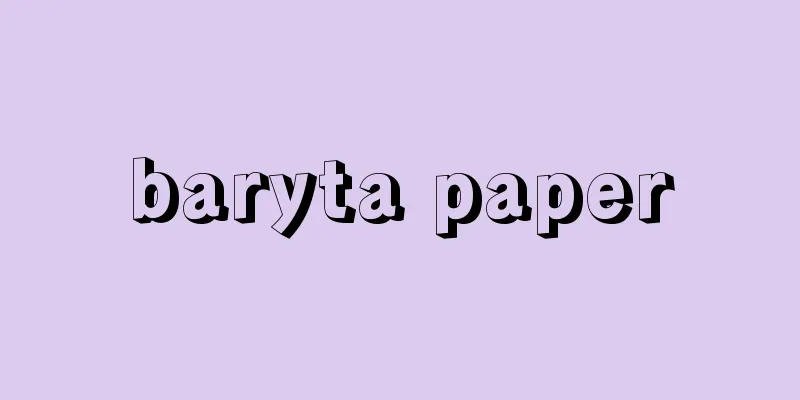Basal ganglia

|
A group of nerve nuclei located at the base of the cerebrum that, together with the cerebellum, influence the activity of the cerebral cortex via the thalamus, controlling voluntary movement and other higher brain functions. [Structure of the basal ganglia] The basal ganglia are composed of the following nuclei (1) to (4) (Figure 1). (1) Striatum (contains the caudate nucleus, putamen, and ventral striatum (including the nucleus accumbens). (2) Globus pallidus (contains the external segment of the globus pallidus, the internal segment of the globus pallidus, and the ventral pallidum). (3) Subthalamic nucleus. (4) Substantia nigra (divided into the substantia nigra pars reticulata and the substantia nigra pars compacta). Among these, the striatum and subthalamic nucleus are the inputs of the basal ganglia, receiving glutamatergic excitatory inputs from a wide area of the cerebral cortex. On the other hand, the internal pallidum and the substantia nigra pars reticulata are the outputs. Some of the information processed in the basal ganglia is projected to the brainstem, but most of it returns to the cerebral cortex, especially the frontal lobe, via the thalamus (cortico-basal ganglia loop). The motor loop, which is a representative of this cortico-basal ganglia loop, starts in motor areas such as the primary motor cortex, supplementary motor area, and premotor cortex, returns to the motor area via motor-related areas of the basal ganglia and thalamus, and controls the movements of the limbs and trunk. In addition, there are the eye movement loop, frontal association area loop, and limbic loop, and the corresponding cerebral cortex areas and basal ganglia form homologous loops in parallel, controlling eye movements, higher brain functions, emotions, etc. (Figure 2). [Direct, indirect, and hyperdirect pathways] The projection neurons of the striatum, which is the input site, are divided into two types according to the transmitter and the projection site. The STN is also an input site, so information is sent from the input site to the internal pallidum and substantia nigra reticulata, which are the output sites, via the following three pathways (Figure 2). 1) Direct pathway: Among the projection neurons of the striatum, neurons with GABA (gamma-aminobutyric acid), substance P, and dopamine D1 receptors project directly to the internal pallidum and substantia nigra reticulata. 2) Indirect pathway: Among the projection neurons of the striatum, neurons with GABA, enkephalin, and dopamine D2 receptors polysynaptically reach the internal pallidum and substantia nigra reticulata via the external pallidum and the STN. 3) Hyperdirect pathway: A pathway in which STN neurons that receive input from the cerebral cortex project to the internal pallidum and substantia nigra reticulata. The striatum, external segment of globus pallidus, internal segment of globus pallidus, and substantia nigra pars reticulata are composed of GABAergic inhibitory neurons, and the subthalamic nucleus is composed of glutamatergic excitatory neurons. Therefore, the direct pathway acts inhibitoryly on the internal segment of globus pallidus and substantia nigra pars reticulata, whereas the indirect pathway acts excitatory (as it has two inhibitory projections). The hyperdirect pathway transmits input from the cerebral cortex to the internal segment of globus pallidus and substantia nigra pars reticulata more quickly than the direct and indirect pathways, transmitting excitatory signals. On the other hand, the substantia nigra pars compacta is composed of dopaminergic neurons, which project to the striatum and act excitatory on direct pathway neurons via D1 receptors and inhibitory on indirect pathway neurons via D2 receptors. [Functions of the basal ganglia] The basal ganglia are thought to play a role in selecting the optimal movement depending on the situation or learning appropriate movements, as follows: (1) Selection of movement. The output of the basal ganglia consists of inhibitory neurons, which are active continuously and at a high frequency, so the thalamus, which is the destination of the projection, is always in an inhibited state. When the striatum is activated by input from the cerebral cortex, the internal pallidum and the substantia nigra pars reticulata are temporarily inhibited via the direct pathway. As a result, inhibition from the output is temporarily removed (disinhibition), the thalamus, which is the destination of the projection, and the cerebral cortex beyond it are excited, and the necessary movement is triggered at the appropriate time. On the other hand, the hyperdirect pathway and indirect pathway excite the internal pallidum and the substantia nigra pars reticulata over a wide area, strengthening inhibition of the thalamus and inhibiting unnecessary movements. (2) Learning of movement. Dopaminergic neurons in the substantia nigra pars compacta code reward information, and when a desired movement is performed, dopamine is released into the striatum. As a result, synaptic efficiency between the cerebral cortex and the striatum changes, and only desirable movements are reinforced and learned as motor procedures. [Basal ganglia disease] When damage occurs to the basal ganglia, the following pathological conditions make it difficult to perform voluntary movements. (1) Parkinson's disease When dopaminergic neurons in the substantia nigra compacta degenerate and fall off, excitatory input via D1 receptors to direct pathway neurons in the striatum and inhibitory input via D2 receptors to indirect pathway neurons are lost, resulting in inability to fully disinhibit the thalamus and akinesia/hypokinesia. (2) Huntington's disease In the early stages, selective degeneration and loss of indirect pathway neurons in the striatum results in inability to inhibit unnecessary movements and involuntary movements (chorea). (3) Dystonia The activity of the direct and indirect pathways increases, causing involuntary movements. [Stereotactic surgery] For Parkinson's disease and other conditions, symptoms can be improved by performing stereotactic surgery such as coagulation of the thalamus or globus pallidus internal segment, or deep brain stimulation (DBS), which involves inserting electrodes into the globus pallidus internal segment or subthalamic nucleus and applying high-frequency continuous stimulation. DBS of the globus pallidus internal segment is effective for dystonia. →Motor area →Intractable neurological disease [Atsushi Nanbu] The white, black, and gray arrows indicate glutamatergic excitatory projections, GABAergic inhibitory projections, and dopaminergic projections, respectively (Nambu, A. et al., 2000, with some modifications) . Figure 2 Neural circuits surrounding the basal ganglia The human brain is shown in a frontal section and a perspective view from the side (upper left) (Nambu Atsushi, "The Cerebral Cortex and the Basal Ganglia," in Standard Physiology, 7th edition, edited by Ozawa Seiji and Fukuda Koichiro, p. 369, Igaku-Shoin, 2009) Figure 1 Nuclei that make up the basal ganglia Latest Sources Psychology Encyclopedia Latest Psychology Encyclopedia About Information |
|
大脳の基底部に存在する一連の神経核群で,小脳とともに視床を介して大脳皮質の活動に影響を与え,随意運動やその他の高次脳機能を制御している。 【大脳基底核の構造】 大脳基底核は,以下の⑴から⑷の神経核から成り立っている(図1)。⑴線条体striatum 尾状核caudate nucleus,被殻putamen,腹側線条体ventral striatum(側坐核nucleus accumbensを含む)から成る。⑵淡蒼球pallidum,globus pallidus 淡蒼球外節external segment of the globus pallidus,淡蒼球内節internal segment of the globus pallidus,腹側淡蒼球ventral pallidumから成る。⑶視床下核subthalamic nucleus。⑷黒質substantia nigra 黒質網様部substantia nigra pars reticulata,黒質緻密部substantia nigra pars compactaに分かれる。このうち,線条体と視床下核が大脳基底核の入力部で,大脳皮質の広い領野からグルタミン酸作動性の興奮性入力を受けている。一方,淡蒼球内節と黒質網様部は出力部で,大脳基底核で処理された情報は,一部は脳幹に投射するが,大部分は視床を介して再び大脳皮質,とくに前頭葉に戻る(大脳皮質-大脳基底核ループcortico-basal ganglia loop)。この大脳皮質-大脳基底核ループの代表である運動ループは,一次運動野,補足運動野,運動前野などの運動領野から始まり,大脳基底核・視床の運動関連領域を介して運動領野に戻り,四肢や体幹の運動を制御している。それ以外に眼球運動ループ,前頭連合野ループ,辺縁ループなどがあり,それぞれ対応する大脳皮質領野と大脳基底核が相同なループを並列に形成し,眼球運動や高次脳機能,情動などを制御している(図2)。 【直接路・間接路・ハイパー直接路】 入力部である線条体の投射ニューロンは,伝達物質と投射部位によって2種類に分けられ,視床下核も入力部であるので,以下の3経路によって入力部から出力部である淡蒼球内節と黒質網様部に情報が送られる(図2)。⑴直接路direct pathway 線条体の投射ニューロンのうち,GABA(γアミノ酪酸),P物質,ドーパミンD1受容体をもつニューロンが,直接,淡蒼球内節と黒質網様部に投射する経路。⑵間接路indirect pathway 線条体の投射ニューロンのうち,GABA,エンケファリン,ドーパミンD2受容体をもつニューロンが,淡蒼球外節と視床下核を順に経由して,多シナプス性に淡蒼球内節と黒質網様部に至る経路。⑶ハイパー直接路hyperdirect pathway 大脳皮質から入力を受けた視床下核ニューロンが,淡蒼球内節と黒質網様部に投射する経路。線条体,淡蒼球外節,淡蒼球内節,黒質網様部はGABA作動性の抑制性ニューロン,視床下核はグルタミン酸作動性の興奮性ニューロンより成り立っているので,直接路は淡蒼球内節と黒質網様部に抑制性に働くのに対し,間接路は(抑制性投射を2回介しているので)興奮性に働く。ハイパー直接路は,大脳皮質からの入力を,直接路・間接路よりも速く淡蒼球内節と黒質網様部に興奮性に伝える。一方,黒質緻密部はドーパミン作動性ニューロンにより構成され,線条体に投射し,直接路ニューロンに対してはD1受容体を介して興奮性に,間接路ニューロンに対してはD2受容体を介して抑制性に働く。 【大脳基底核の機能】 大脳基底核は,以下のように,状況に応じて最適な運動を選択すること,あるいは適切な運動を学習することに役立っていると考えられる。⑴運動の選択。大脳基底核の出力部は抑制性ニューロンより成り,高頻度で連続して活動しているので,投射先である視床はつねに抑制された状態にある。大脳皮質からの入力によって,線条体が活動すると,直接路を介して,淡蒼球内節と黒質網様部が一時的に抑制される。その結果,出力部からの抑制が一時的に除かれ(脱抑制),投射先である視床や,その先にある大脳皮質が興奮し,必要な運動が適切なタイミングで引き起こされる。一方,ハイパー直接路や間接路は,淡蒼球内節と黒質網様部を広範囲に興奮させ,視床に対する抑制を強め,不必要な運動を抑制している。⑵運動の学習。黒質緻密部のドーパミン作動性ニューロンは報酬情報をコードしており,望ましい運動が遂行されると線条体にドーパミンが放出される。その結果,大脳皮質-線条体間のシナプス効率が変化し,望ましい運動のみが強化され,運動手続きとして学習される。 【大脳基底核疾患】 大脳基底核に障害が生じると,以下のような病態により随意運動の遂行が困難になる。⑴パーキンソン病Parkinson's disease 黒質緻密部のドーパミン作動性ニューロンが変性・脱落すると,線条体の直接路ニューロンへのD1受容体を介した興奮性入力と,間接路ニューロンへのD2受容体を介した抑制性入力が消失し,その結果として視床を十分に脱抑制できなくなり,無動・寡動を示す。⑵ハンチントン病Huntington's disease 初期においては,線条体の間接路ニューロンが選択的に変性・脱落するので,不必要な運動を抑制できなくなり,不随意運動(舞踏運動)が生じる。⑶ジストニアdystonia 直接路・間接路の活動性が亢進し,不随意運動が生じる。 【定位脳手術stereotactic surgery】 パーキンソン病などに対して,視床や淡蒼球内節の凝固,あるいは淡蒼球内節や視床下核に電極を挿入し高頻度連続刺激を加える脳深部刺激療法deep brain stimulation(DBS)などの定位脳手術を施すと,症状が改善する。ジストニアに対しては,淡蒼球内節のDBSが有効である。 →運動領野 →神経難病 〔南部 篤〕 白,黒,灰色の矢印は,それぞれグルタミン酸作動性の興奮性投射,GABA作動性の抑制性投射,ドーパミン作動性投射を示す (Nambu,A. et al.,2000を一部改変)"> 図2 大脳基底核をめぐる神経回路 ヒトの脳の前額断と側面からの透視図(左上)で示す(南部篤「大脳皮質と大脳基底核」 小澤瀞 司・福田康一郎総編集『標準生理学』第7版369頁, 医学書院,2009)"> 図1 大脳基底核を構成する核 出典 最新 心理学事典最新 心理学事典について 情報 |
<<: Collection of delinquent taxes - Tainoshobun
>>: Cerebrum - dainou (English spelling)
Recommend
Liquid discharge - Electric discharge
…In the latter case, the energy source is limited...
well spacing
… [Oil well] The first problem in developing a ne...
Ḥalab (English spelling) Halab
…Population: 1,542,000 (1994). Arabic: Ḥalab. Loc...
Kaiser
…(2) Caesar was originally a Latin family name, b...
Zhuang Qiao; Chuang Ch`iao
A military commander in the Warring States period ...
Official - Kan
〘 noun 〙① "Public" as opposed to "p...
incomplete dominance
...On the other hand, I A and I B are dominant ov...
Oshisaka Palace
According to the Kojiki and Nihon Shoki, the pala...
barrier
…Amanohashidate in Miyazu Bay and Yumigahama in Y...
Kvass (Russia)
A Russian mildly alcoholic drink. It is made by f...
Metal industry
A general term for the manufacturing industry tha...
Cooperative Society (English spelling)
It is a cooperative organization in which economi...
Exclusivist - Exclusivist
…However, since parolees, as well as prisoners wh...
Fang movement - Gakkou
A middleman who mediates commercial transactions ...
Aérospatiale [Company] (English spelling)
The largest national aircraft manufacturer in Fran...






![Andre [company] - Andre](/upload/images/67cf4fcecec45.webp)


